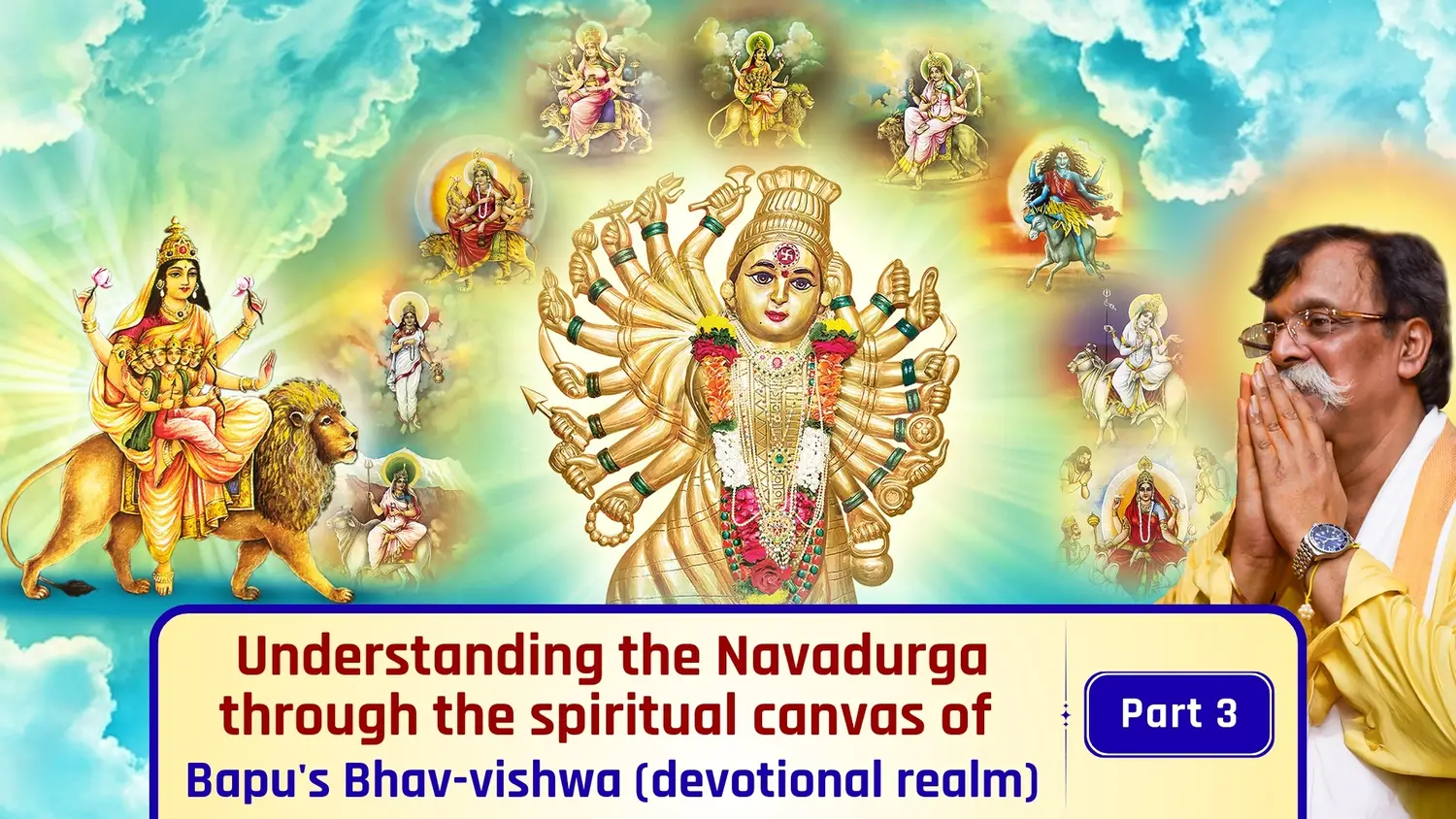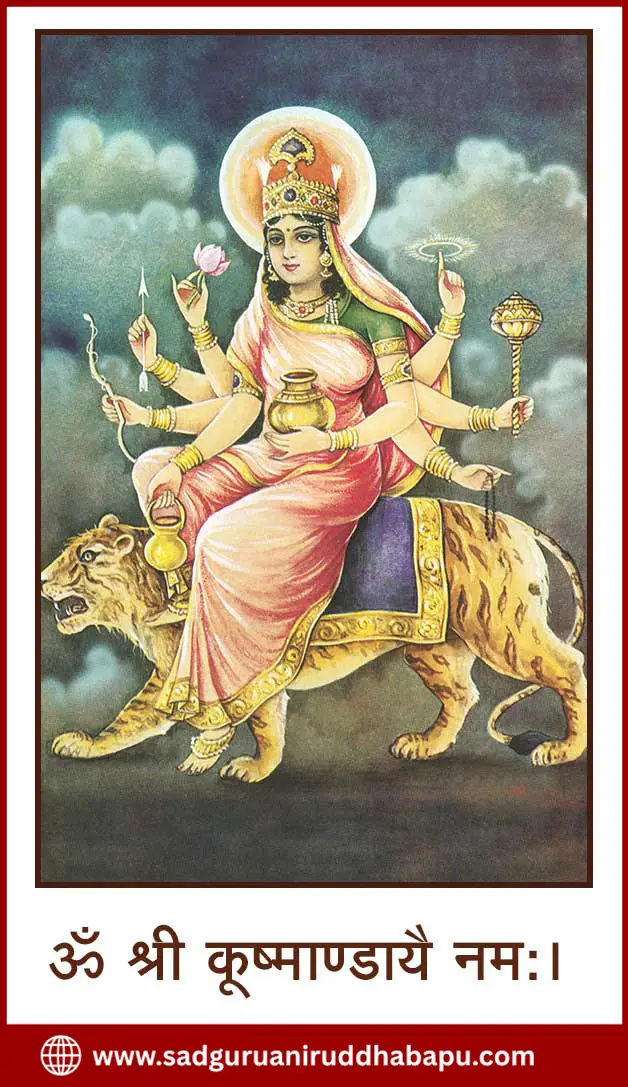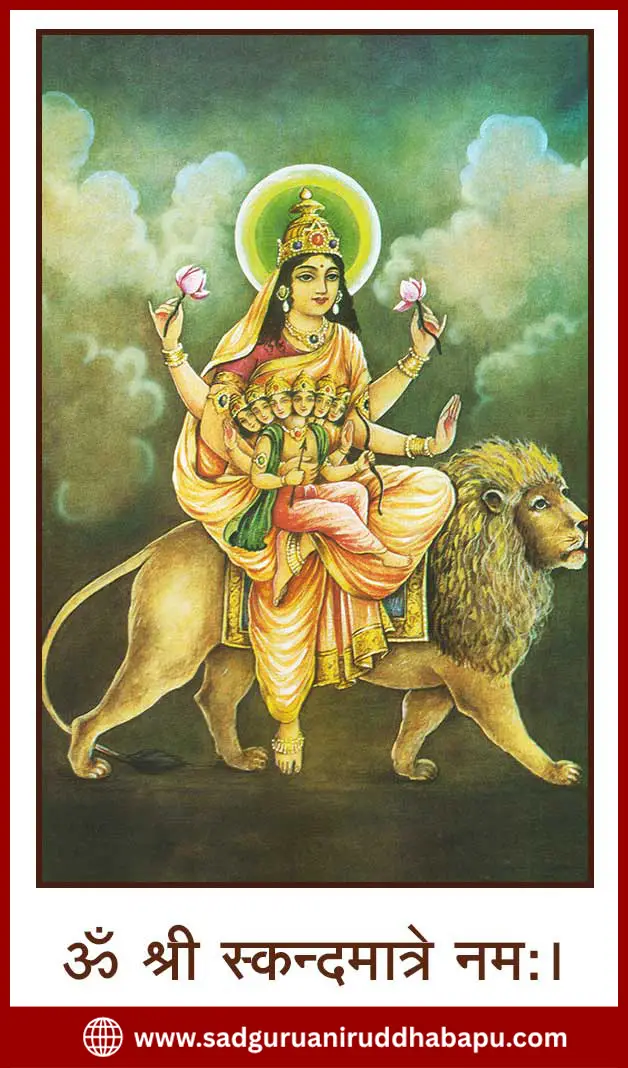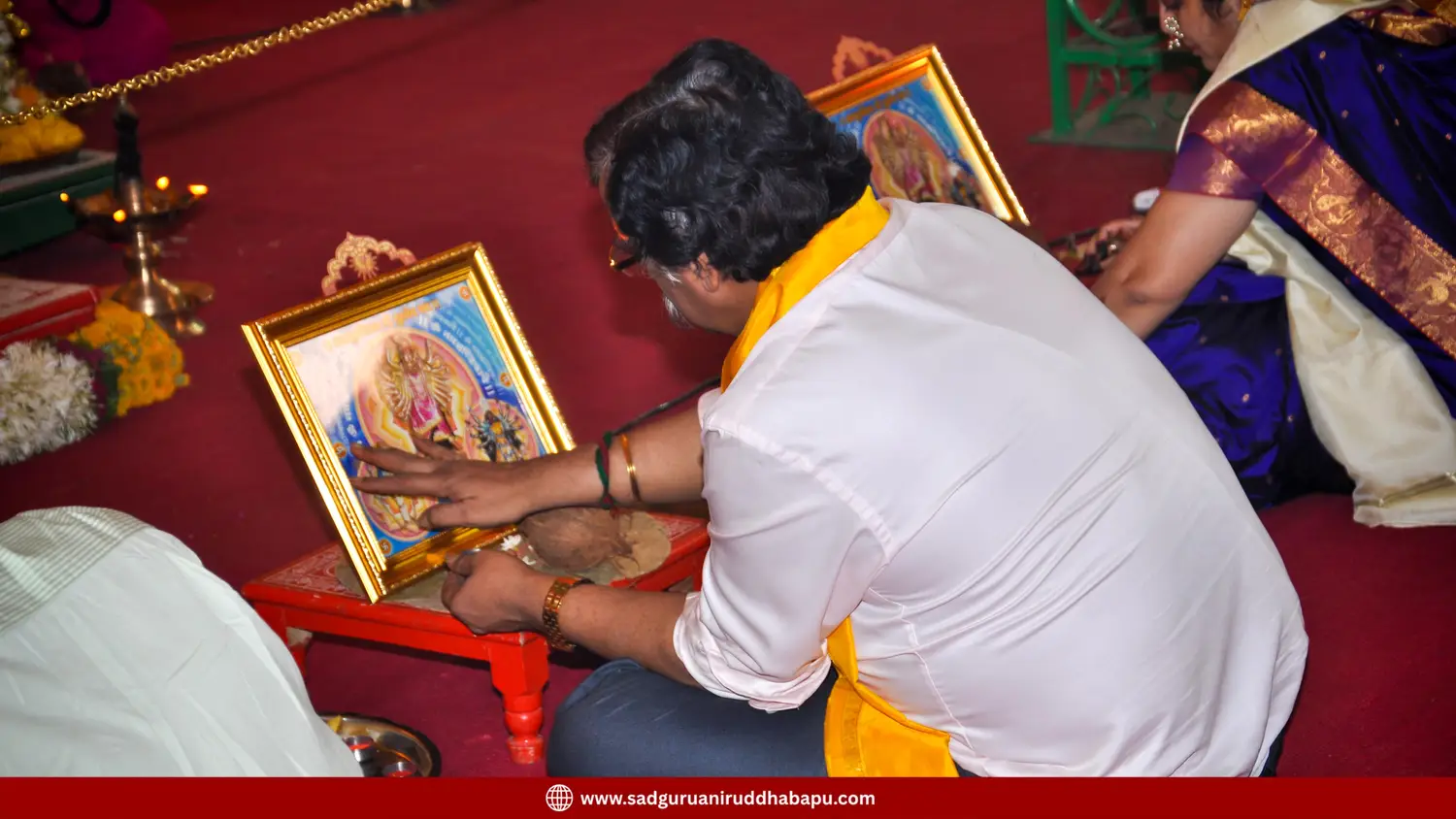Understanding the Navadurga through the spiritual canvas of Bapu's Bhav-vishwa (devotional realm) - Part 3

Previoust Article Next Article
मराठी हिंदी ગુજરાતી বাংলা తెలుగు മലയാളം
Reference: From the editorials no. 1384 and 1385 in the Tulsipatra series of the daily ‘Pratyaksha’ by Sadguru Shree Aniruddha Bapu.
In the Tulsipatra editorial no. 1384, Sadguru Shree Aniruddha Bapu writes:
Sage Gautama, reverently prostrated and asked Brahmavadini Lopamudra,
“O Mother, the giver of knowledge! While studying the rays of the Sun and thus the solar system, I had the darshan of Mother Kushmanda and that too in the centre of every sun-disc. I saw her seated on a tiger, moving among the Sun and the solar-like constellations. Would you kindly reveal the mystery behind this?”
Lopamudra looked at Gautama with admiration and replied,
“O pure-minded Gautama! Your study is indeed progressing in the right manner, and you are a truthful and sincere seeker.
Your truthfulness itself is the Sun that dispels all forms of darkness in human life. This very truthfulness is extremely dear to Mother Kushmanda; hence she granted you her darshan.
Every human being develops an intense desire to know the truth at various stages in life, and it is Mother Kushmanda alone who unfolds such truth to each one depending on their spiritual authority.

It is from the smile of this very Mother Kushmanda that all Suns and stars have come into being because she is the original source of radiance; therefore, she is called ‘Kashi.’ Even if the brilliance of all the stars in all the universes were to be combined, it would still pale before a mere fraction of her radiance. That is why, even while moving close to the Sun and the stars, she remains unaffected.
On the contrary, it is she who makes the Sun’s direct rays, which reach the Earth, bearable for life here.
Without light, no creation is possible, and without her, there is no light. Therefore, she is also called ‘Sahasraprakashasundari’ – the one with an infinite radiance.
It was her worship that Brahmarshi Kashyapa had performed, and the knowledge he passed on to you was first bestowed upon him by her. And so, to remain Ambadnya to her i.e., indebted to her, Brahmarshi Kashyapa, along with Yadnyavalkya, Vashishtha, and the family of Brahmarshis, organized a yadnya. It was during this yadnya that Kushmanda manifested from the sacred fire and asked for ‘bali’ (offering).
All the Brahmarshis were perplexed. Sacrificing animals was against their principles. Therefore, they invoked Mother Anasuya, who immediately appeared in her eighteen-armed form and declared, “On Earth, the fruit called Kushmanda (ash gourd) is most beloved to my original form. Hence, offer the Kushmanda fruit as ‘bali’ without any hesitation. I shall stand witness right here.”
As per Anasuya’s instructions, Brahmarshi Kashyapa offered a fresh and lively ash gourd (Kushmanda) as ‘bali’ to Mother Kushmanda. At that moment, all the Brahmarshis realized that this offering of Kushmanda fruit was the only one capable of pacifying even the fierce forms of the Adimata.
The Kushmanda who manifested from that yadnya lovingly accepted the Kushmanda offering and assured all the performers of the yadnya that “For every form of the Adimata and for myself, the Kushmanda fruit offering will be the highest.”
Gautama, study the Kushmanda fruit carefully. It has the unique quality of absorbing the Sun’s scorching heat.
Just as no creation is possible without light, in the same way, no creation is possible without rasa (essence), and the existence of rasa is impossible without water.
Therefore, by accepting the offering of the Kushmanda fruit, the fourth Navadurga, Kushmanda Parvati, began preparing to become Skandamata.
By blending the essence (rasa) of Kushmanda with her radiance of sun, she adopted gentleness and coolness. It was thus that Skanda, the son of Shiva and Parvati, could be born.
This fifth Navadurga, Skandamata, is the presiding deity of the ninth and tenth steps of the Shambhavi Vidya and the presiding deity of the day and night of the fifth day of Navratri.
Now, a young Rishikumari (female sage), dazzling with radiance and stunning beauty, rose with utmost humility. While rising, she had already sought permission from Brahmavadini Poornahuti, which everyone noticed. Yet, no one knew who she was.
Looking at this female sage, Lopamudra asked with motherly affection, “Dear, what is your question?”
With half-closed eyelids, she asked, “Parvati, who can easily bear the radiance of all the Suns, could not withstand the Virya of Shiva and the sacred conception arising from it. How is this possible? There must be some sacred and extremely secret mystery behind this. I always wish to explore this mystery, and for that, I wish to worship Skandamata. To whom should I go?”
Brahmavadini Lopamudra called her closer, blessed her by smelling the crown of her head, and said, “O Rajarshi Shashibhooshan and Brahmavadini Poornahuti! This your daughter, True to your name, is indeed ‘A-halya.’
Bapu further writes in the Tulsi Patra editorial no. 1385:
Lopamudra spoke softly with Ahalya for a while and asked her to return to her mother and sit beside her. Then she began to speak, “This Ahalya has indeed expressed an excellent and sacred desire.
The worship of Navadurga Skandamata can be performed by both men and women, by both ascetics and householders, by both the wealthy and the poor, by both the learned and the ignorant. There is no question about it.
This is because Navadurga Skandamata blesses her sons and daughters not only with qualities such as valor, courage, war conscience, and aggressiveness but also with the ability to forgive at the right time and to endure hardships cheerfully.

It is because of these very qualities that countless noble and valorous kings were born on Earth.
Whenever in Bharat the decline of Sanatan Dharma begins due to the attacks of unrighteous forces, at that time, this very Navadurga Skandamata endows some of her worthy devotees with all these qualities and reinstates Sanatan Vedic Dharma to its supreme position.
Whenever her worship has been performed in the past, excellent generals, just like Skanda Kartikeya, have arisen in Bharat.
Now, in the form of Bhandasura, similar anti-Bharat demons have arisen in the region of Shyena (China). Hence, O Ahalya, through your study and spiritual practice (Sadhana), the right environment will certainly be created for the destruction of Bhandasura.
On the ninth and tenth steps of Shambhavi Vidya, one must wage fierce battles in both spiritual practice and worldly life against many forces that oppose progress. For this, it is extremely essential to learn how to fight demonic tendencies.
This is because demonic tendencies enter the human mind through the vultures of Vritrasura and thereby keep increasing the demonic forces on Earth.
Skanda Kartikeya works to completely eradicate such demonic tendencies from the human mind. For this, he does not need his own practice alone but requires the practice of Navaratri Sadhana and the form of the Adimata that is made up of the essence of knowledge and the essence of valour.
This form of the Adimata is called ‘Shreelalitambika.’

While feeding her son Skanda for the first time, this Navadurga Skandamata first uttered the ‘Lalitasahasranama.’ Therefore, the recitation, study, contemplation, and meditation on the ‘Lalitasahasranama’ become the main practice on the ninth and tenth steps of Shambhavi Vidya.
O Ahalya, Bhagwan Hayagriva himself has recently taught the Lalitasahasranama to Sage Markandeya. Go to Brahmarshi Markandeya, become his disciple, and practice the Lalitasahasranama. Attain the Siddhi (metaphysical power) of ‘Vajradapi Kathorani, Mriduni Kusumadapi’ – harder than a diamond and softer than a flower.
It is this very principle that Navadurga Skandamata has in abundance.
O pure-minded Gautama, it is my instruction that you should also go with her to the ashrama of Brahmarshi Markandeya.”
Hearing Lopamudra’s instruction, Rajarshi Shashibhooshan felt a little worried out of concern for his daughter. Sending an unmarried and young daughter on a long journey with an unmarried and young sage did not seem right to him. But Brahmavadini Poornahuti was extremely delighted.
When Shashibhooshan whispered his concern to his wife, she smiled and whispered back, “You are forgetting only one word – ‘Anuroop’ – mutually suitable.”
Brahmavadini Lopamudra was observing and understanding everything. She called Sage Gautama and the Sage Ahalya close to her, and she also called the parents of Gautama, Kashyapa, and the parents of Ahalya.
Everyone agreed, and joy spread over Kailash. For everyone present there fully approved of and liked the mutual suitability of this couple.
Brahmarshi Vashishtha and Brahmavadini Arundhati themselves took charge of the wedding arrangements.
Gautama married Ahalya and immediately set out with her towards the ashram of Brahmarshi Markandeya.
Everyone present there wished that this newly married couple should get at least some time after marriage to live a life free from hardships and with some comfort.
Understanding the feelings in everyone’s minds, Bhagwan Hayagriva himself appeared there, bowed to the Adimata, and said, “O Adimata, I can seat this newly married couple on my back and take them to Markandeya’s hermitage in just a moment. Thus, the time of twenty-nine days of their journey will become available to them for the beginning of their married life.”
The Adimata gladly gave permission to Bhagwan Hayagriva.
Bhagwan Hayagriva carried Gautama and Ahalya on his shoulders and, folding his hands, asked the Adimata, “O Adimata, while all the Brahmarshis and Maharshis have gathered here, why is Markandeya alone still sitting in his own ashram?”
The Adimata Shrividya answered, “Navabrahmarshi Markandeya has stayed waiting for you.”
